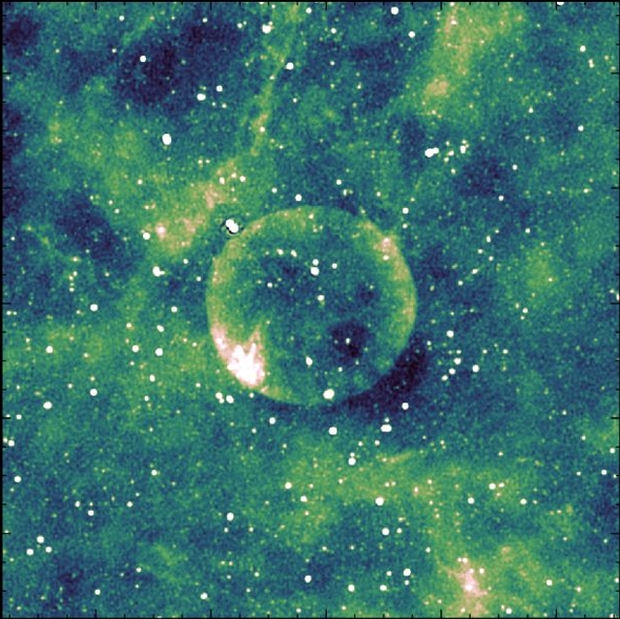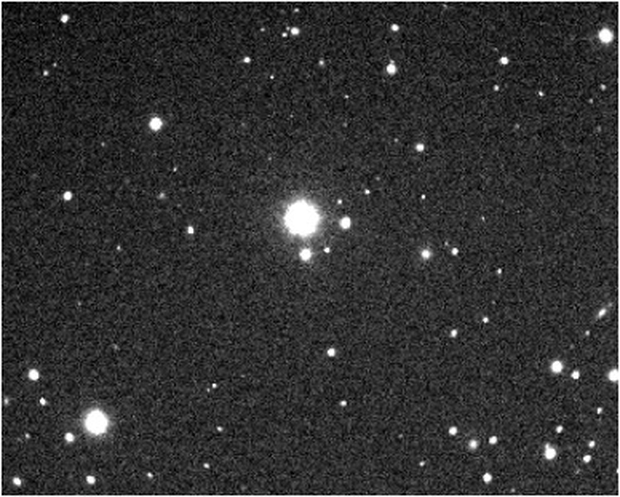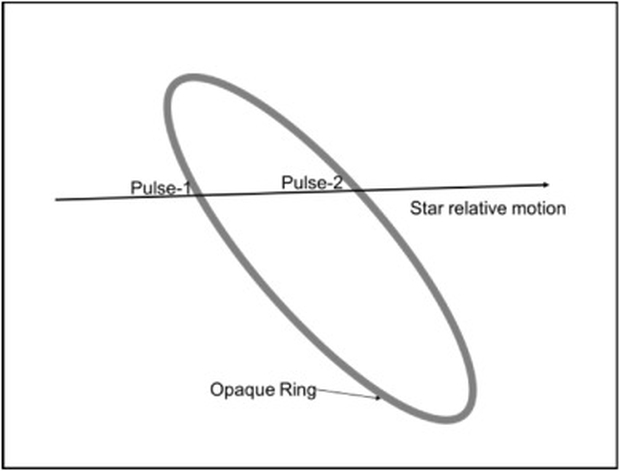Finding unusual things in the sky should no longer astound us. It’s pretty much par for the course these days in astronomy, what with new instrumentation like JWST and the soon to be arriving Extremely Large Telescope family coming online. Recently we’ve had planet-forming disks in the inner reaches of the galaxy and the discovery of a large molecular cloud (Eos by name) surprisingly close to our Sun at the edge of the Local Bubble, about 300 light years out.
So I’m intrigued to learn now of Teleios, which appears to be a remnant of a supernova. The name, I’m told, is classical Greek for ‘perfection,’ an apt description for this evidently perfect bubble. An international team led by Miroslav Filipović of Western Sydney University in Australia is behind this work and has begun to analyze what could have produced the lovely object in a paper submitted to Publications of the Astronomical Society of Australia (citation below). Fortunately for us, Teleios glows at radio wavelengths in ways that illuminate its origins.

Image: Australian Square Kilometre Array Pathfinder radio images of Teleios as Stokes (the Stokes parameters are a set of numbers used to describe the polarization state of electromagnetic radiation). Credit: Filipović et al.
I’m not going to spend much time on Teleios, although its wonderful symmetry sets it apart from most supernova remnants without implying anything other than a chance occurrence in an unusually empty part of space. Its lack of X-ray emissions is a curiosity, to be sure, as the authors point out:
We have made an exhaustive exploration of the possible evolutionary state of the SN based on its surface brightness apparent size and possible distances. All possible scenarios have their challenges, especially considering the lack of X-ray emission that is expected to be detectable given our evolutionary modelling. While we deem the Type Ia scenario the most likely, we note that no direct evidence is available to definitively confirm any scenario and new sensitive and high-resolution observations of this object are needed.
Odd Optical Pulses
So there you are, a celestial mystery. Another one comes from Richard Stanton, now retired but for years a fixture at JPL, where he worked on Voyager, among other missions. These days he runs Shay Meadow Observatory near Big Bear, CA where he deploys a 30-inch telescope coupled with a photometer designed by himself for the task at hand – the search for optical SETI signals. Thus far the indefatigable retiree has observed more than 1300 stars in this quest.
Several unusual things have turned up in his data. What they mean demands further study. The star HD 9389 produced “two fast identical pulses, separated by 4.4s,” according to the paper on his work. That was interesting, but even more so is the fact that looking back over his earlier data, Stanton realized that a pair of similar pulses had occurred in observations of the star HD 217014 that were taken four years before. In the ‘second’ observation, the twin pulses were separated by 1.3 seconds, 3.5 times less than for the HD 89389 event. But Stanton notes that while the separation is less, the pulse shapes and separation are very similar in both events.
Stanton’s angle into optical SETI differs from the norm, as he describes it in a paper in Acta Astronautica. The work is:
…different from that employed in many other optical SETI searches. Some [3,4] look for nanosecond pulses of sufficient intensity to momentarily outshine the host star’s light, as first suggested by Schwartz and Townes [5]. Others search optical spectra of stars for unusual features [6] or emission close to a star that could have been sent from an orbiting planet [7]. The equipment used here is not capable of making any of these measurements. Instead it relies on detecting unexplained changes in a star’s light as indications of intelligent activity. Starting with time samples of 100μs, the search is capable of detecting optical pulses of this duration and longer, and also of finding optical tones in the frequency range ∼0.01–5000Hz.
HD 89389 is an F-class star about 100 light years away from the Solar System. Using the equipment Stanton has been working with, all kinds of things can present a problem, everything from an airplane blocking out starlight, satellites (a growing problem because of the increasing number of Internet access satellites), meteors and birds. Atmospheric scintillation and noise has to be accounted for as well. I’m simplifying here and send you to the paper, where all these factors are painstakingly considered. Stanton’s analysis is thorough.
Here is a photograph which shows the typical star-field during an observation of HD 89389, with the target star in the center of a field that is roughly 15 × 20 arcmin in size. The unusual pulses from this star occurred during this exposure.

Image: The HD 89389 star-field. “A careful examination was made of each photograph to detect any streaks or transitory point images that might have been objects moving through the field. Nothing was found in any of these frames, suggesting that the source of the pulses was either invisible, such as due to some atmospheric effect, or too far away to be detected.” Credit: Richard Stanton.
A closer look at these unusual observations: They consisted of two identical pulses, with the star rapidly brightening, then decreasing in brightness, then increasing again, all in the fraction of a single second. The second pulse followed 4.2 seconds later in the case of HD 89389, and 1.3 seconds later at HD 217014. According to Stanton, in over 1500 hours of searching he had never seen a pulse like this, in which the star’s light is attenuated by about 25 percent.
Note this: “This is much too fast to attribute to any known phenomenon at the star’s distance. Light from a star a million kilometers across cannot be attenuated so quickly.” In other words, something on the scale of a star cannot partially disappear in a fraction of a second, meaning the cause of this effect is not as distant as the star. If the star’s light is modulated without something moving across the field of view, then what process could cause this?
The author argues that the starlight variation in each pulse itself eliminates all the common signals discussed above, from airplanes to meteors. He also notes that unlike what happens when an asteroid or airplane occultation occurs, the star never disappears during the event. The second event, in the light of the star HD 217014, was discovered later, although the data were taken four years earlier. Stanton runs through all the possibilities, including shock waves in the atmosphere, partial eclipses by orbiting bodies, and passing gravity waves.
One way of producing this kind of modulation, Stanton points out, is through diffraction of starlight by a distant body between us and the star. Keep in mind that we are dealing with two stars that have shown the same pattern, with similar pulses. Edge diffraction results when light is diffracted by a straight edge, producing ‘intensity ripples’ that correspond to the pulses. The author gives this phenomenon considerable attention, explaining how the pulses would change with distance but coming up short on a distance to the sources here.
From his conclusion:
The fact that these pulses have been detected only in pairs must surely be a clue to their origin. How can the two detected events separated by years, and from seemingly random directions in the sky, be so similar to each other? Even if the diffraction theory is correct, these data alone cannot determine the object’s distance or velocity.
He goes on to produce a model that could explain the pulses, using the figure below.

This thin opaque ring, located somewhere in the solar system, would sequentially occult the star as it moved across the field. If anything like this were found, it would immediately raise the questions of where it came from and how it could survive millions of years of collisions with other objects. Alternatively, if the measured transverse velocity proved greater than that required to escape our solar system, a different set of questions would arise. Whatever is found, those speculating that our best chance of finding evidence of extraterrestrial intelligence lies within our own solar system [15], might have much to ponder!
If there is indeed some sort of occulting object, observations with widely spaced telescopes could potentially determine its size and distance. Meanwhile, a third double pulse event has turned up in Stanton’s data from January 18, 2025, where light from the star HD 12051 is found to pulse, with the pulses separated by 1.52 seconds. This last observation doesn’t make it into the paper other than as a footnote, but it’s an indication that Stanton may be on to something that is going to continue creating ripples. As in the case of Teleios, we have an unusual phenomenon that demands continued observation.
The paper on the unusual circular object is Filipović et al., “Teleios (G305.4-2.2) — the mystery of a perfectly shaped new Galactic supernova remnant,” accepted at Publications of the Astronomical Society of Australia and available as a preprint. The paper on the pulse phenomenon is Stanton, “Unexplained starlight pulses found in optical SETI searches,” Acta Astronautica Vol. 233 (August 2025), pp. 302-314. Full text. Thanks to Centauri Dreams readers Frank Henriquez and Antonio Tavani for the pointer to this work.



The double “occultation” observations analysis is very interesting. The author suggests that the shape of the light curves indicates light diffraction, rather than a simple occlusion of the starlight. The 2 observed events have different separations, and the events are from very different parts of the sky.
Ideally, we need at least a 3rd event to determine if the events are due to a single object traveling in a line, rather than independent events. The need for at least a 2nd telescope in a different location is needed to determine whether the phenomenon is extraterrestrial in distance or local, just as the SETI searches need to eliminate local RFI.
The author eliminates aircraft, but I wonder if at least 2 aircraft, in a flight of military jets flying in formation, might fit the bill? The analysis of ground speed should be able to eliminate this explanation. The ground speed of subsonic jets is about 250 m/s. Figure 23 of the paper would seem to eliminate that explanation.
The object needn’t be a circle, although this is a nice Platonic object. It could be any object with separated masses, possibly rotating wrt. the line of sight, like the suspected binaries of many larger KBOs,
Could it be a weather balloon or even more outlandish a cosmic string.
https://images.newscientist.com/wp-content/uploads/2019/08/18133558/string-theory-c480bn_web.jpg?width=837
Yes, the occultations seem well worth following up on. A third pair for the same star would start to constrain possible orbits.
It would also be useful to know what occultations by the propellors of a drone would look like. Would these produce the raised shoulders?
What’s really surprising is the extreme speed of the phenomenon, which was repeated, but also the very *regular* drop in luminosity during those few hundredths of a second that you can see perfectly on the curves, then the return to normal luminosity, which was just as regular. Personally, it reminds me of some kind of energy absorption…
come on, let’s go crazy: a type II civilisation on interstellar supra-luminal voyage that takes x amount of energy from the stars it encounters to move forward ;)
thank you Paul for the quality of your subjects
Fascinating !
Paul, the star HD 9389 is missing the “8” in front of it.
What is the speed of Earth’s rotation in Big Bear, CA? I’m considering whether ETC is using a planet that emits a beam similar to David Kipping’s “Terrascope,” but in reverse, focusing it on Earth. The rotation of the Earth would create a very short period.
The “Terrascope”: On the Possibility of Using the Earth as an Atmospheric Lens
https://arxiv.org/abs/1908.00490
>What is the speed of Earth’s rotation in Big Bear, CA?
Roughly ~1470 km/h pour 34°N
If you look at these stars in Aladin, DSS2, blue they all have some contrails near them or going towards it for HD 12051, could be artifacts of the image processing though. Just stick the Target star number in and away you go.
https://aladin.cds.unistra.fr/AladinLite/
Those are artifacts in the optics or sensors caused by the relative brightness of the stars
They look like satellite trails to me as they are straight and if you zoom out you can see others.
Hey, whatever happened to Tabby’s Star? Did astronomers get tired of it being a possible Dyson Shell/Swarm?
https://en.m.wikipedia.org/wiki/Tabby%27s_Star
I think it was put down to an orbiting cold dust cloud.
Do you have details on this? What about the other stars with similar traits?
Some dimming occuered in 2017 as well
https://encyclopedia.pub/entry/34107
The two phenomena are separated by a time lapse that is very short on a stellar scale (~4 seconds), but which could be related to optoelectronics: could it be due to a synchronization signal in an optical transmission?
Given this information, here’s what the AI suggests (it’s a line of thought) :
“In optical communication systems, light pulses are used to transmit information. The temporal separation between these pulses, often of the order of a few seconds, is crucial to avoid interference and ensure efficient transmission. Although a separation of 4.4 seconds is relatively long for optical pulses, it could be relevant in specific contexts, such as signal synchronization in communication networks.”
But in this case, we are just dealing with the em radiation being received by the sensor and relayed electronically to software for storage. If there were some artifact of signal processing (e.g., garbage collection by the code), then this artifact would likely be very common. I would not doubt that the signal recorded was what the sensor was receiving, and it is a result of an external event, such as the possibilities the author describes in the paper. AFAIK, a digital camera doesn’t create such artifacts when taking pictures, which is what we are essentially talking about here. Granted, the author’s system is homebuilt, but why that should generate these rare, but distinctive, symmetric signals is not clear to me.
This is probably not relevant, and differs in detail from the events described in the post, but the rings of Uranus were discovered when they occulted a star:
https://en.wikipedia.org/wiki/Rings_of_Uranus
Some explanations of the phenomenon can be found by searching for “odd radio circle” (ORC) :
https://arxiv.org/abs/2402.09708
In spanish to translate:
https://www.dw.com/es/astr%C3%B3nomos-observan-fantasmas-circulares-misteriosamente-perfectos-en-el-universo-radioel%C3%A9ctrico/a-72601154
I was so excited to read the full article. It was in IRG’s daily list of relevant articles. Of course I immediately leapt to the vision of a dyson swarm or my dyson shutter concept published in these pages until the diffraction details popped that balloon.
There were other stars nearby in the image: why were they not occulted?
Wondering if the three stars have been plotted to see how they line up which could indicate an orbiting ring… obviously a stargate!